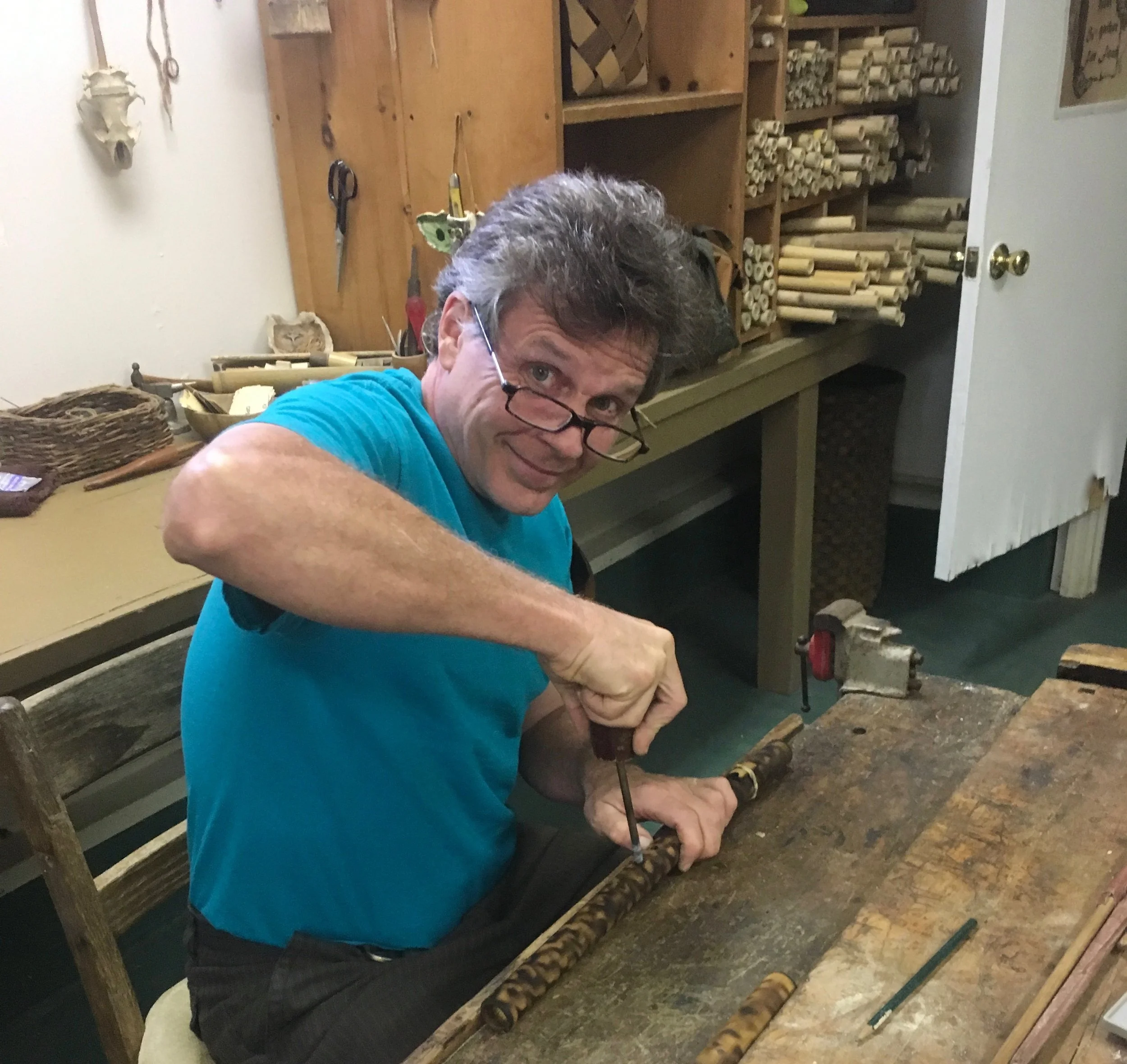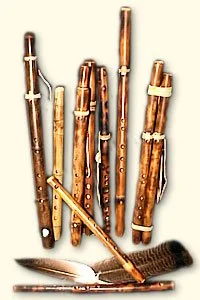Hawk has been handcrafting rivercane and bamboo styles of Native American flutes since 1991
Hawk Hurst has a real passion for Native American-style flutes and drums. Originally self-taught, Hawk is forever grateful to the assistance he received in learning to craft flutes, from Orea Van Doren and Cherokee Elders, Eddie Bushyhead & Hawk Littlejohn. His playing was influenced by his mentor, Snowbear Taylor. Hawk first studied Native American-style drum making, in 1987, with Northwest Coast drum-maker, Jim Hickey. Hawk’s educational background includes a Masters of Science degree in Environmental Education from Lesley College and the Audubon Expedition Institute, as well as undergraduate degrees in Psychology and in Political Science from the University of Oklahoma. He is a nine time recording artist and is the author of two published children’s books, ‘The Story of the First Flute’ and ‘The Way of the Forest’.

Rivercane and Bamboo - Materials Matter
The smaller diameter, higher pitched flutes are created from a type of native grass known as rivercane (Arundinaria Gigantea). Larger diameter, deeper toned flutes are crafted from many different types of Asian Bamboo. When materials are available, two of my favorite types to craft with are Black bamboo (Phyllostachys nigra) and clumping bamboo (Fargesia murielae). Rivercane and bamboo both make excellent flutes, and like all musical instruments, they work best when cared for properly. I have found that both cane and bamboo are best cut in the winter months in order to allow them to cure properly. I allow each piece to dry for several months, sometimes years, before crafting them into flutes.
Rivercane, known as ihy’a in the Cherokee language, has long provided indigenous people in the Southeast with an important resource for making baskets, blowguns, flutes, arrows, spears, and much more. Cane grass once prospered along the banks of nearly every waterway throughout the Southeastern United States. Today, it is much less common due to a variety of environmental pressures. Rivercane is often confused with its closest grass relative, bamboo, which was most likely brought to the Americas by the first Asian immigrants or to serve as scaffolding at rock quarries.
Caring for Rivercane and Bamboo Flutes
As with all cherished musical instruments, it is best to store your flute away from pets and small children and to avoid extremely hot locations. You may wish to apply a small amount of Walnut oil over the entire flute if you are concerned that your flute may be drying out too much. The advice provided above will help prevent your flute from cracking and will allow your flute to live a long, musical life. The ‘bird’, or block, which is tied down with a piece of tanned leather, should sit directly over the ‘nest’ and the first ‘egg’ - (the first hole, closest to the end you will be breathing into). It is important that the “bird” be tied down tightly, and that it sits directly on top of that first hole and the burned groove separating the two holes. The second hole (from the end you are blowing into) should be easy to see and not covered by the ‘bird’.
Native American Flute Stories & Traditions
The traditional end-blown, two-chambered flute, with 5 or 6 holes, is believed by many musicologists to be the same style that was made and most favored by native peoples throughout the Southeast, prior to European or African contact.
The Cherokee People of the Southeastern Woodlands often speak of this instrument as a gift from Woodpecker, while certain tribes of the arid Southwest credit Kokopelli, the humpbacked flute-player, with having brought this wonderful magic stick to the People. In the Great Plains, it was referred by many of the Lakota and Cheyenne People as the Love Flute. Young men and women relied upon its charm and magic during courtship. It has often been associated with the Elk in the West and the Loon in the Northeast. Sometimes made with only 2 or 3 holes, these flutes were often used to cast spells and confuse opponents during the intense stickball games, known as “the Little Brother of War”, contested often between the First Nations people of the Southeast. Regardless of who created the first flute, we can all be grateful for its gift!
Playing Your Native American style Flute
When beginning to play, cover all 5 (or 6) finger holes - the ones farthest from the end you are blowing into. Gently breathe into the end of the flute. As you slowly release the finger hole at the bottom of the flute, slightly increase the amount of air you are blowing into the flute. Release the next finger hole and increase air flow each time you lift a finger, proceeding up the scale. There is more to it than that, but for now, give that a try. Practice, patience, and time will result in beautiful music escaping from your flute!



